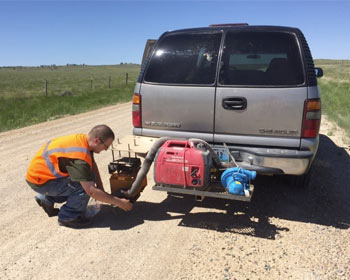MPC
Research Published on Model to Help Target Dust Suppression on Unpaved Roads
Posted: Jan 1, 2020
 Research at the University of Wyoming into the development of a model to help local road managers select optimum sections of unpaved roads for chemical treatments for dust suppression was recently published online and will appear in the March issue of the Journal of Infrastructure Systems. Because Wyoming is a leading producer of coal, oil, and natural gas, its unpaved roads have more traffic which results in significant dust emissions. To reduce these emissions, the state currently uses calcium chloride and magnesium chloride as dust suppressants. Because its budget is limited, all 12,000 miles of unpaved roads cannot be treated every year. Based on previous research that identified key factors that contribute to dust generation, the researchers developed a model to identify which unpaved roads should be treated given the limited budget. "Numerical Model to Optimize Selection of Unpaved Roads for Dust Suppressing Chemical Treatments: Case Study" was written by Promothes Saha, assistant professor of civil and mechanical engineering at Purdue University Fort Wayne, Nikolai Greer, graduate research assistant in the Department of Civil and Architectural Engineering at the University of Wyoming, and Khaled Ksaibati, director of the Wyoming Technology Transfer Center and MPC director for the University of Wyoming.
Research at the University of Wyoming into the development of a model to help local road managers select optimum sections of unpaved roads for chemical treatments for dust suppression was recently published online and will appear in the March issue of the Journal of Infrastructure Systems. Because Wyoming is a leading producer of coal, oil, and natural gas, its unpaved roads have more traffic which results in significant dust emissions. To reduce these emissions, the state currently uses calcium chloride and magnesium chloride as dust suppressants. Because its budget is limited, all 12,000 miles of unpaved roads cannot be treated every year. Based on previous research that identified key factors that contribute to dust generation, the researchers developed a model to identify which unpaved roads should be treated given the limited budget. "Numerical Model to Optimize Selection of Unpaved Roads for Dust Suppressing Chemical Treatments: Case Study" was written by Promothes Saha, assistant professor of civil and mechanical engineering at Purdue University Fort Wayne, Nikolai Greer, graduate research assistant in the Department of Civil and Architectural Engineering at the University of Wyoming, and Khaled Ksaibati, director of the Wyoming Technology Transfer Center and MPC director for the University of Wyoming.

